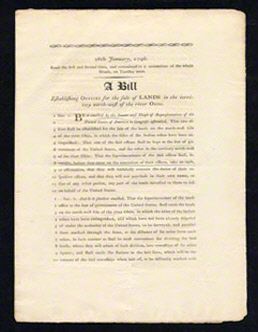
FINE, UNRECORDED DRAFT OF THE PUBLIC LAND ACT OF 1796, AN IMPORTANT STEP IN OPENING UP AMERICA’S WESTERN FRONTIER
(CONGRESS). A Bill Establishing Offices for the Sale of Lands in the Territory North-west of the River Ohio. [Philadelphia]: no publisher, January 26, 1796. One folio sheet, loose as issued, printed on laid paper with "DELAWARE" and spread-wing eagle with shield watermarks, folded into two leaves, printed on all four pages, uncut. Housed in a custom clamshell box. $8500.
Unrecorded draft of the momentous Public Land Act of 1796, the legislation that, however imperfectly, helped inaugurate America’s western expansion, “setting the rhythm of American social development for a century to come.”
When the American Revolution ended, the new nation encompassed approximately 560 billion acres of land. Thousands of potential settlers eagerly looked toward the frontier—not least the recently decommissioned soldiers of the Continental Army, who had been promised tracts of land in return for their service—but America's young government faced an undeniable tension between encouraging expansion and raising revenue. "The young Republic needed whatever revenue it could get but at the same time a considerable number of statesmen, led by Thomas Jefferson, saw the desirability of putting the land as rapidly as possible into the hands of people who would render it productive" (Banta, 275). In the Land Ordinance of 1785, Congress made its first provisions for surveying and selling lands in the public domain. Unfortunately, the Ordinance's surveying requirements slowed the pace of settlement; furthermore, the law ultimately favored wealthy speculators over willing, but less prosperous, pioneers: "the least amount of land one could buy from the government at 640 acres for a minimum price of $1.00 an acre… The average settler did not have $640 for the minimum purchase… Another difficulty was that, with 18th-century methods, it took two full military squads of men to farm 640 acres and this new land, offered in such large parcels, could not be worked by slaves because of its location in free territory" (Banta, 275).
This fine document emerges, then, from ongoing disputes in the 1790s, disputes whether policies should be directed at using public lands mainly as a source of revenue or at helping actual settlers easily obtain land" (Foner & Garraty, 877). It is an unrecorded draft of what would become the Public Land Act of 1796, and it reveals several of the changes necessary to secure the Act's passage. In this draft, for instance, Congress provides for larger division of lands "on the north-west side of the river Ohio, in which the titles of the Indian tribes have been extinguished" (a reference to the 1795 treaty signed at Greenville, in which Confederated Indians ceded two-thirds of present Ohio and some of southeastern Indiana) into "only… tracts of three miles square." The final version, in contrast, included a provision stipulating smaller 640-acre lots in half of the new townships; it also established acreage, not mileage, as the means for measuring plots.
In the end, the 1796 Act awarded victory in the struggle between settlement and revenue to revenue. The legislation "made permanent the rectangular system of survey with townships of six miles square. Half of the townships in the newly surveyed area were to be sold in quarter-townships of 5120 acres each… The alternate townships were to be divided and sold as sections of 640 acres" (Gates, History of Public Land Law Development). It also raised the minimum price of a government acre of land to $2.00. Not until the Harrison Land Law of 1800 would individual, common settlers enjoy greater access to public land. Even so, the 1796 Act—of which this document preserves an early form—managed to "set the pattern of the American West. Ranges, townships and sections marched across the continent with the pioneer, imposing their rigid triangles on forest, plain and mountain… The Act of 1796, drafted by ordinary members of an average Congress, set the rhythm of American social development for a century to come" (Morrison & Commager, The Growth of the American Republic). Not in Evans, Bristol or Shipton & Mooney.
A rare and important, contemporary glimpse of America's initially halting attempts to chart its westward course, in fine condition.